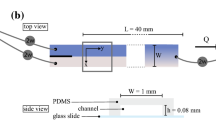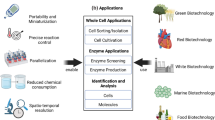Abstract
By the use of an experimental setup for microfluidic flows, we have characterized the separation and concentration characteristics of the so-called Trilobite™ separation unit. Our separation unit consists of microfluidic channels and an elliptical separation geometry with a solid and a permeable wall region. We show that it is possible to adjust the thickness of different flow layers by changing the flow rates and pressure drop over the permeable wall. For high pressure drops, the separator shows promising concentration characteristics. For low pressure drops, an increase in flow rate results in a thinning of the flow layers. For sufficiently high flow rates, it should therefore be possible to create flow layers sufficiently thin that the particle separation is entirely dominated by hydrodynamic forces. This, in turn, will enable clog-free particle separation.







Similar content being viewed by others
References
Bruus H (2008) Theoretical microfluidics. Oxford master series in condensed matter physics. Oxford University Press, New York
Cowen EA, Monismith SGM (1997) A hybrid digital particle tracking velocimetry technique. Exp Fluids 22:199–211. doi:10.1007/s003480050038
Dong T, Yang Z, Su Q, Tran NM, Egeland EB, Karlsen F, Zhang Y, Kapiris MJ, Jakobsen H (2011) Integratable non-clogging microconcentrator based on counter-flow principle for continuous enrichment of CaSki cells sample. Microfluid Nanofluid 10(4):855–865. doi:10.1007/s10404-010-0717-x
Grandison AS, Lewis MJ (1996) Separation processes in the food and biotechnology industries: principles and applications. Woodhead Publishing Limited, Cambridge
Hönsvall BK, Altin D, Robertson LJ (2016) Continuous harvesting of microalgae by new microfluidic technology for particle separation. Bioresour Technol 200:360–365. doi:10.1016/j.biortech.2015.10.046
Hood K, Kahkeshani S, Di Carlo D, Roper M (2016) Direct measurement of particle inertial migration in rectangular microchannels. Lab Chip. doi:10.1039/C6LC00314A
Jäggi RD, Sandoz R, Effenhauser CS (2007) Microfluidic depletion of red blood cells from whole blood in high-aspect-ratio microchannels. Microfluid Nanofluid 3(1):47–53. doi:10.1007/s10404-006-0104-9
Jhansi SC, Mishra SK (2013) Wastewater treatment and reuse: sustainability options. Cons J Sustain Dev. doi:10.7916/D8JQ10Q1
Kay JM (1953) Boundary-layer flow along a flat plate with uniform suction. Technical report, Mech. E. Cambridge University Engineering Laboratory
Karimi A, Yazdi S, Ardekani AM (2013) Hydrodynamic mechanisms of cell and particle trapping in microfluidics. Biomicrofluidics 7(2):021501. doi:10.1063/1.4799787
Kolaas J (2016) Getting started with hydrolabPIV v1.0. Preprint series research report in mechanics. http://urnnbno/URN:NBN:no-53997
Kolaas J, Jensen A, Mielnik M (2013) Visualization and measurements of flows in micro silicon y-channels. Eur Phys J E 36(2):1–11. doi:10.1140/epje/i2013-13019-x
Lenshof A, Laurell T (2010) Continuous separation of cells and particles in microfluidic systems. Chem Soc Rev 39:1203–1217. doi:10.1039/B915999C
Lim E (2014) Inertio-elastic focusing of bioparticles in microchannels at high throughput. Nat Commun 5: doi:10.1038/ncomms5120
Meinhart CD, Wereley ST, Gray MHB (2000) Volume illumination for two-dimensional particle image velocimetry. Meas Sci Technol 11(6):809. http://stacks.iop.org/0957-0233/11/i=6/a=326
Meinhart CD, Wereley ST, Santiago JG (1999) Piv measurements of a microchannel flow. Exp Fluids 27(5):414–419. doi:10.1007/s003480050366
Mielnik MM, Ekatpure RP, Saetran LR, Schonfeld F (2005) Sinusoidal crossflow microfiltration device-experimental and computational flowfield analysis. Lab Chip 5:897–903
Mossige E, Jensen A, Mielnik M (2015) Characterization of the trilobite hydrodynamic particle separation microchip with \(\mu\)piv. In: Proceedings of the 11th international symposium on particle image velocimetry—PIV2015, Santa Barbara, CA, USA, September 14–16, 2015
Nabeth S Jeremy, Chigullapalli S, Alexeenko AA (2010) Knudsen force modeling in application to microsystems. Technical report, School of Aeronautics and Astronautics Faculty Publications. Paper 26. doi:10.2514/6.2010-5054
Pamme N (2007) Continuous flow separations in microfluidic devices. Lab Chip 7:1644–1659. doi:10.1039/B712784G
Park JS, Choi CK, Kihm KD (2004) Optically sliced micro-PIV using confocal laser scanning microscopy (CLSM). Exp Fluids 37(1):105–119. doi:10.1007/s00348-004-0790-6
Rivet C, Lee H, Hirsch A, Hamilton S, Lu H (2011) Microfluidics for medical diagnostics and biosensors. Chem Eng Sci 66(7):1490–1507. doi:10.1016/j.ces.2010.08.015
Saffman PG (1965) The lift on a small sphere in a slow shear flow. J Fluid Mech 22:385–400. doi:10.1017/S0022112065000824
Schlichting H (1968) Boundary-layer theory, 6th edn. McGraw-Hill series in mechanical engineering. McGraw-Hill, New York
Sugaya S, Yamada M, Seki M (2011) Observation of nonspherical particle behaviors for continuous shape-based separation using hydrodynamic filtration. Biomicrofluidics 5(2):024103. doi:10.1063/1.3580757
Svanes K, Zweifach B (1968) Variations in small blood vessel hematocrits produced in hypothermic rats by micro-occlusion. Microvas Res 1(2):210–220. doi:10.1016/0026-2862(68)90019-8
Tilton N, Cortelezzi L (2015) Stability of boundary layers over porous walls with suction. AIAA J 53(10):2856–2868
Tobias CW, Eisenberg M, Wilke CR (1952) Fiftieth anniversary: diffusion and convection in electrolysisa theoretical review. J Electrochem Soc 99(12):359C–365C. doi:10.1149/1.2779636. http://jes.ecsdl.org/content/99/12/359C.full.pdf+html
Wereley ST, Lueptow RM (2015) Microscopy u: Water immersion objectives. http://www.microscopyu.com/articles/optics/waterimmersionobjectives.html
White FM (1991) Viscous fluid flow. McGraw-Hill series in mechanical engineering. McGraw-Hill, New York
WHO/UNICEF Joint Monitoring Programme for Water Supply and Sanitation (2004) Meeting the MDG drinking water and sanitation target: a mid-term assessment of progress. http://apps.who.int/iris/bitstream/10665/43021/1/9241562781.pdf?ua=1
WWAP (United Nations World Water Assessment Programme) (2015) The United Nations world water development report 2015: water for a sustainable world. http://unesdoc.unesco.org/images/0023/002318/231823E.pdf
Yamada M, Seki M (2005) Hydrodynamic filtration for on-chip particle concentration and classification utilizing microfluidics. Lab Chip 11:1233–1239
Zhu T, Ye W, Zhang J (2011) Negative Knudsen force on heated microbeams. Phys Rev E 84:056,316. doi:10.1103/PhysRevE.84.056316
Zhu T, Ye W (2010) Origin of knudsen forces on heated microbeams. Phys Rev E 82:036,308. doi:10.1103/PhysRevE.82.036308
Acknowledgements
This project was funded by Trilobite and The Research Council of Norway–Project Number 232148. Support was also received from the Norwegian micro- and nanofabrication Facility (NORFAB) infrastructure project.
Author information
Authors and Affiliations
Corresponding author
Additional information
The original article was revised: The sentence “Mean flow is from right to left.” in caption of Fig. 7 was incorrect. This sentence has been corrected.
An erratum to this article is available at http://dx.doi.org/10.1007/s10404-016-1833-z.
Appendix: Calculation of the total flux
Appendix: Calculation of the total flux
The total flux, \(Q_{\rm tot}=Q_{p}\) + \(Q_{c}\), is slightly changed when the saddle point is moved from the upstream to the downstream position. The change, however, is less than 2% for the lowest flow rate, corresponding to \(Re=2.8\), and less than 1% for the intermediate flow rate (\(Re=29\)), and could be neglected. The permeate flow rate \(Q_p\) for \(Re=58\) and downstream saddle point position is unknown because parts of the permeate flow layer is outside the field-of-view of the objective lens. Therefore, the total flow rate is unknown. But since \(Q_{\rm tot}\) changes by 1% for \(Re=29\) when the saddle point is moved between the upstream and downstream position, we assume that this is also true for the highest flow rate (\(Re=58\)). We therefore assumed that the total flux \(Q_{\rm tot}\) for the downstream saddle point was the same as for the upstream saddle point, which we knew, and calculated the permeate flux from \(Q_{p}=Q_{\rm tot} -Q_{c}\).
Rights and permissions
About this article
Cite this article
Mossige, E.J., Jensen, A. & Mielnik, M.M. An experimental characterization of a tunable separation device. Microfluid Nanofluid 20, 160 (2016). https://doi.org/10.1007/s10404-016-1826-y
Received:
Accepted:
Published:
DOI: https://doi.org/10.1007/s10404-016-1826-y




